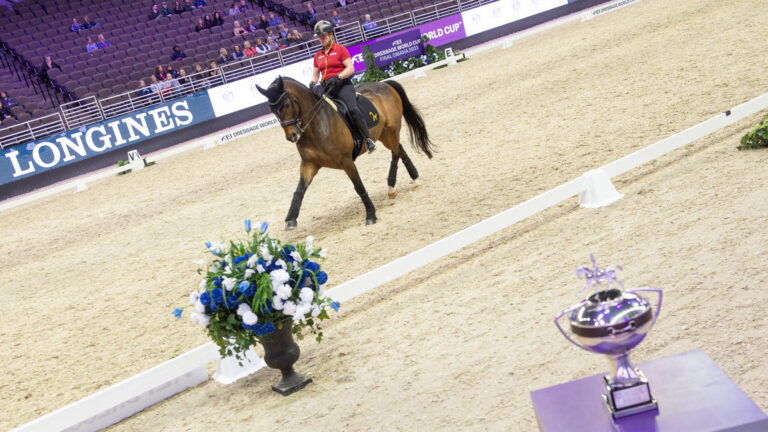Growing up riding hunt seat, galloping racehorses and riding
through the woods, I had always assumed horses were either born with a stretchy, reaching “on the bit” head and neck carriage, or they weren’t—unless they were eating grass. When
introduced to dressage, it was the first time in my riding career I
realized that any horse could not only be put “onto the bit” but
could also be taught to stretch his head and neck down,
an exercise closely connected to putting a horse onto the bit.
I also learned that stretching a horse’s head and neck is a key
element of gymnasticizing him.
In the early days, I did not know the difference between a “good” stretch—one that
gymnasticizes a horse’s entire body involving his back—and a “bad” stretch—one that
involves only the front part of a horse ‘s body. I was happy if my horse put her head and
neck down. A head that’s down, however, is not a reliable indicator for a stretch with
gymnastic value. Let me explain why. Horses, unlike people, do not have collar bones.
Their shoulder blades are attached to their bodies strictly by soft tissue. There are no joints
connecting the front legs and shoulder blades to the horse’s rib cage. When grazing, in
order for the horse to reach the ground, he lowers his entire rib cage through his shoulder
blades so he can reach the ground. Under saddle, when we let the reins out to stretch a
horse, some horses will immediately dive down and “seek the ground” in this manner. They
drop their rib cage as if they were grazing. This is a stretch that doesn’t involve the horse’s
back but a mechanical dropping of the rib cage. In fact, when a horse has dropped his rib
cage to lower his neck, this will put him more on his forehand. He will compensate by hollowing
his back and usually putting his hind legs out behind. Although his nose may reach
the ground, it is not because the horse has stretched over his back, it’s because he has
dropped his rib cage.
In order to achieve a good stretch, where the horse’s entire body is involved, it is best
to start the stretch on a circle, establishing a good bend around your inside leg. The bend
helps to keep the horse’s inside hind leg engaged and keeps him balanced. Make sure
the horse stays stepping forward to your outside rein (inside leg driving toward the outside
rein while establishing bend with the inside rein and limiting the amount of bend with the
outside rein). Then gradually let the reins out while maintaining the bend around your leg .
Even if your horse does not reach far down with his nose in the beginning, the stretch on
the circle will keep him off his forehand and stretch his back and neck muscles. Start at the
walk, then try it at the trot.
Stretching a horse on a straight line is more difficult. To graduate from a circle to a
straight line, do some preparatory work. I usually establish a good bend in the corner before
coming across the diagonal, then come out of the corner in a little shoulder-fore. Then I
gradually let the reins out. Sta rt with a free walk on a long rein (remember, a long rein still
requires contact), then try it at the trot.
Whenever I feel a horse drop his back when I school him, I immediately circle, re-establish contact and bend and then try again.
Using this exercise, eventually the horse
will learn to keep his back up.
For an observer, it can be hard to tell if the stretch is good or bad. Indications of a bad stretch are if the horse dives down into the contact at the beginning or snatches the reins. Another clue is if he goes down quickly and immediately comes back up. A rider might feel, or an observer might see, the back behind the saddle hollow out and stiffen. He may also see or feel the horse’s hind end drop out behind the rider. Another indication of a bad stretch is when the horse is difficult to pick back up and be put on the bit after the stretch.
In a good stretch, you should feel as
if you were on top of the world and that
your horse is strong in his back and hindquarters. The horse should remain rideable
in the stretch. That is, you should be able to control the bend and tempo with the
horse still accepting the contact. The horse should stretch into the contact at the same speed as you lengthen your reins. There
should be no hesitation in the stretch as
you let the reins out. A good stretch is not just a movement in the tests. It can be a
nice way to warm-up and gymnastically
supple your horse. It can also be used as
a reward for the horse and a welcome
break from collected work. Stretching a horse furthers his athleticism.
Judy Westlake is a U.S. Dressage Federation silver and gold medalist, a Certified
Instructor and a Graduate Core Instructor for the Balimo Equestrian Program. She has studied with Sue Blinks, Gunnar Ostergaard and Karl Mikolka. She teaches clinics throughout the United States and trains out
of Florida and Vermont. Her website is judywestlake.com.
This article first appeared in the March 2008 article of Dressage Today.











